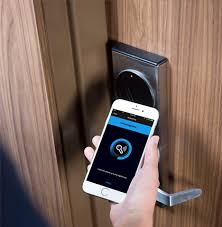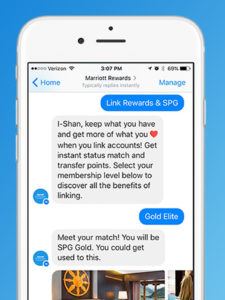At home in a hotel: Mass customization at Marriott

Supply chain digitization offers Marriott an opportunity to deliver customized experiences and deepen guest relationships. Is the investment worth it?
Is your first impulse to check Expedia or TripAdvisor before a hotel brand’s website? You’re not alone. Over the past decade, Online Travel Agencies (OTAs) have experienced the strongest revenue growth of all hotel distribution channels – bad news for large hotel brands like Marriott International given high OTA commissions of 15-30% [1]. As OTAs start to offer their own points-based loyalty programs that compete with Marriott Rewards, many fear this trend will only accelerate [2].


Today’s focus: A more agile service supply chain
In hotels, services that need to be customized to individual guests have historically involved layers of middlemen in the service delivery chain. Since 2015, Marriott has been attempting expedite services through its use of the Marriott MobileApp to directly deliver information from operating systems to the guest [4].
For instance, checking into a room typically requires two transfers of information: from the operating system to the front desk, and from the front desk to the consumer. Marriott Mobile Key – now offered at 30 properties – eliminates the middle step of this chain by allowing the guest to check in remotely and use their phone as a key, bypassing the front desk [5]. Similarly, the app’s Mobile Requests feature allows guests to request on-property amenities and services specific to their own needs with no intermediary interaction; even highly custom requests can be communicated using the app’s 2-way chat feature [6].
Marriott hopes to use machine learning and AI to improve the quality of customization: for instance, tailoring recommendations provided over the 2-way chat feature based on the guest’s profile and historical stay behavior [7]. Thom Kozik, VP of Global Loyalty at Marriott, told Skift: “Whether it’s posted information on social media or shared locations — we can make more attuned suggestions to you later this year. It’s all about data and how we can use machine learning to go one step further” [8].

By hosting value-add features on owned technology channels like the MobileApp, the company can restrict a tangible benefit to guests who book direct. By using machine learning to improve execution with increased stays, the company can also motivate guests to maximize share of wallet with Marriott.
Looking forward: The next frontier of enabling technology
While Marriott has made significant strides at the global corporate level, I believe the company should turn its focus to advancements at the property level.
For app-enabled features like Mobile Key, the company has now created a platform for flexibility and control by the end consumer. A key short-term investment the company should now make is in scaling up paired technology at properties to respond to this demand. The 30 properties capable of using Mobile Key represent less than 1% of 6,000+ global Marriott hotels, suggesting most of the opportunity to move the needle still lies in the future [11].
In the medium-term, providing deeper personalization requires access to information about each guest’s interactions with the entire Marriott ecosystem, enabled by integrated technology systems. As the company prepares to merge with Starwood Hotels and Resorts, it must carefully manage the significant risk that visibility could decrease due to the IT challenges inherent in combining two systems and databases [12].
Once the merger is complete, the company will still be left with the challenge of bringing more aspects of guest insight into its mainframe technology platform. Today the platform integrates several facets of guest insight – e.g. booking and Marriott Rewards data; however, in order for it to be truly effective I believe it should bring in other verticals such as spa or food and beverage [13, 14].
Going forward, my primary questions involve the extent of investment these technological changes will require. Which customization initiatives should be scaled up, in the context of limited technology budgets? Considering the holistic and long-term nature of these programs’ intended impact, how can the company best measure ROI to make informed investment decisions?
(789 words)
…
[1] Jill Barthel et al., “OTAs – a Hotel’s Friend or Foe? How Reliant are Hotels on OTAs?” HVS Global Hospitality Report (July 2015), HVS International, Business Source Complete, EBSCO, accessed November 2017.
[2] Ibid.
[3] David Eisen, “Arne Sorenson on why Marriott’s success is never final,” Hotel Management, February 28, 2017, http://www.hotelmanagement.net/development/arne-sorenson-why-marriott-s-success-never-final, accessed November 2017.
[4] Alex Samuely, “Marriott expands mobile requests as keyless room entry takes flight,” Mobile Marketer, November 18, 2015, https://www.mobilemarketer.com/ex/mobilemarketer/cms/news/strategy/21718.html, accessed November 2017.
[5] Marriott International, “Mobile Check-In,” http://mobileapp.marriott.com/#check-in, accessed November 2017.
[6] Chantal Tode, “How Marriott is using mobile messaging to transform visiting a hotel,” Mobile Marketer, May 15, 2015, https://www.mobilemarketer.com/ex/mobilemarketer/cms/news/messaging/20443.html, accessed November 2017.
[7] Deanna Ting, “What Marriott Learned from Starwood’s Loyalty and Digital Expertise,” Skift, February 13, 2017, https://skift.com/2017/02/13/what-marriott-learned-from-starwoods-loyalty-and-digital-expertise/, accessed November 2017.
[8] Ibid.
[9] Ibid.
[10] Connie Rheams, “Winning Strategies for Personalizing your Guest Experience,” Hotel Business Review, n.d., http://hotelexecutive.com/business_review/1708, accessed November 2017.
[11] Marriott International, “About Marriott,” http://www.marriott.com/marriott/aboutmarriott.mi, accessed November 2017.
[12] Deanna Ting, “Marriott CEO: Technology is the Biggest Risk in the Starwood Merger,” Skift, May 9, 2017, https://skift.com/2017/05/09/marriott-ceo-technology-is-the-biggest-risk-in-the-starwood-merger, accessed November 2017.
[13] Marriott International, “Hotel Development,” https://hotel-development.marriott.com/?stop_mobi=yes, accessed November 2017.
[14] “Rethinking the Current State of Hotel Technology,” September 22, 2017, Skift, https://skift.com/2017/09/22/rethinking-the-current-state-of-hotel-technology/, accessed November 12, 2017.
[A] “20 Years of OTAs: How They Transformed the Hotel Industry,” December 13, 2016, Represent Asia News, http://representasianews.com/20-years-of-otas-how-they-transformed-the-hotel-industry/, accessed November 2017.
[B] Marriott International, “Mobile Check-In,” http://mobileapp.marriott.com/#check-in, accessed November 2017.
[C] Marriott International, “News Center,” http://news.marriott.com/2017/09/marriott-internationals-ai-powered-chatbots-facebook-messenger-slack-alofts-chatbotlr-simplify-travel-guests-throughout-journey/, accessed November 2017.



Super interesting! I definitely agree with the premise that the path to digitalization should be prioritized based on ROI so that companies are making the right investment decisions. One way to indirectly tie digitalization efforts to the top-line is through the use of predictive analytics. Digitalization efforts should focus on aspects that actually add value to the customer experience, and are forward-looking rather than a diagnosis of historical behaviors. For example, predictive analytics could help hotels predict what type/ quantity of food inventory to order during various holiday seasons, or make sure to have enough cabs waiting outside at various times based on observed customer behaviors. Predictive analytics can also help determine which digitalization efforts a customer uses and appreciates the most, and individually tailor marketing promotions to those tastes. Hopefully, this should boost profitability while improving services in an increasingly competitive digital market.
http://julysystems.com/5-emerging-technologies-that-are-digitizing-the-hotel-industry/
Thanks for this, Natasha! Given our case this week on Marriott, I was immediately tempted to start thinking about ways that Marriott could use digital technology to more effectively compete not only with OTAs, but with Airbnb and other platforms that are fundamentally technology-based – for instance, through an App-based concierge service that helps drive the “experience” component of a guest’s stay (e.g., restaurant reservations, guide to local attractions, etc.). As I thought about it, though, my gut told me that rather than focusing on the vacation customer, the higher priority customer to target might be the business traveler – someone who would appreciate the convenience offered by mobile check-in or, say, the ability to pre-order room service while en route to the property, and who could represent a high-frequency, high-spend revenue source on an ongoing basis if he/she deems your properties superior to another chain’s. In the long run, I suppose Marriott might take a 2-App approach: one that could focus on the very different needs of its two core customer groups. In the near term, I might prioritize the business customer, but I agree with you that more quantitative analysis might be required to justify!
Great write up!
I do understand the need for digitization as travelers become more tech-savvy and labor becomes increasingly expensive. That said, as a stalwart in the hospitality industry it will be interesting to see how Marriott balances technology with human interaction. Sure, I am happy to use my mobile phone to enter my room. But on vacation I still prefer to have faces at the lobby rather than going through a sterile (human lacking) environment. As this is particularly true when it comes to luxury brands and resorts, I believe Marriott has to tread carefully when it comes to automating everything.